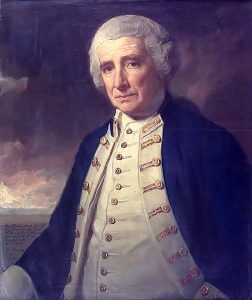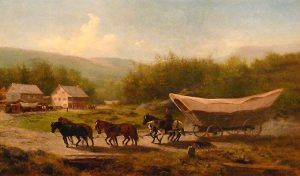Forbes Road was an early Pennsylvania road that was blazed from Carlisle to the Forks of the Ohio River at present-day Pittsburgh, Pennsylvania in 1758. The 200-mile road was built under orders of Brigadier General John Forbes, a British commander in 1758 during the French and Indian War.
Like General Edward Braddock, who built Braddock’s Road, before him, Forbes faced an almost impossible task — that of transporting an army and artillery to the Forks of the Ohio River through a wilderness previously traveled only by Indians, fur traders, and packhorses. Fortunately for Forbes, he had Braddock’s experience to guide him. He realized the importance of supply lines and fortifications, and so built the road at a slow, deliberate pace, constructing forts at regular intervals. He also refrained from engaging the enemy prematurely, lest his army be destroyed before it reached to Fort Duquesne.
In determining his route west, Forbes decided not to make use of Braddock’s Road, a controversial decision that angered Virginians, including George Washington, who accompanied his army. However, Forbes rightly suspected that the Virginians had ulterior motives for advocating Braddock’s route. Virginia and Pennsylvania still contested the ownership of the Ohio Country, and a route cut directly through Pennsylvania would favor that colony’s traders and settlers once the war was over.
Instead, General John Forbes ordered that Raystown Path be utilized as the military road. The path, which had first been cut by Delaware and Shawnee Indians, and later used by fur traders, had been earlier been partially cleared by Colonel James Burd in 1755. The route of Forbes’s army from Carlisle to Raystown (modern Bedford) was relatively easy, thanks to Burd’s improvements. However, west of Raystown, there were no provincial posts to house British troops and the Raystown Traders Path had not been widened for military use.
Called Forbes Road, the new trail was blazed between June and November 1758. Colonel Henry Bouquet, Forbes’ second-in-command, worked ahead of the advancing army to make the improvements and widen the old bridle path. Surmounting rough terrain including the Allegheny Mountains and Laurel Ridge, it took so long to complete that the British did not approach Fort Duquesne until November 24th, when an army would typically suspend operations and move into winter quarters.
Along with Braddock’s Road, Forbes Road was one of the two great western land routes that the British cut through the mid-Atlantic backcountry during the French and Indian War. It made communication and trade easier between the eastern and western portions of the colony and provided an important route west for settlers going to the Ohio Country. Today, anyone who has traveled the Pennsylvania Turnpike between Fort Littleton and Breezewood has followed in the footsteps of Forbes’s army.
Compiled by Kathy Alexander, updated April 2021.
Also See:


